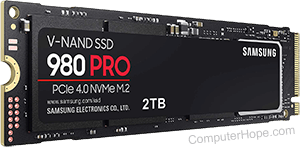NVMe

Non-Volatile Memory Express, also known as NVMe, is a device specification introduced by Intel in 2007. It standardizes how non-volatile memory devices, such as SSDs (solid-state drives), can connect to a computer's PCIe (PCI Express) bus.
Traditionally, SSDs are connected to the computer using a disk drive interface, such as SATA (Serial AT Attachment). However, SATA was designed for older data storage devices, such as HDDs (hard disk drives), and its data transfer speed is limited. In 2005, when SSDs became popular with consumers, the fastest SSDs read data quicker than SATA could transfer it. Manufacturers began producing SSDs that could be installed in a PCIe slot, but their interfaces varied widely. The NVMe standard allows devices to be attached to a computer without requiring separate and possibly conflicting operating system device drivers.
The photo shows a Samsung 980 Pro, an SSD that utilizes NVMe 4.0 M.2 interface technology.
3D XPoint, Computer abbreviations, eMMC, Hardware terms, M.2, PCIe, SSD
